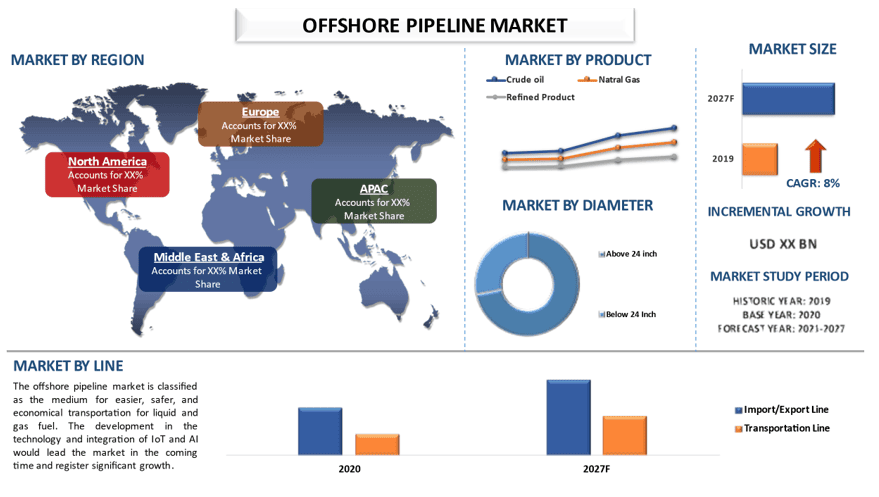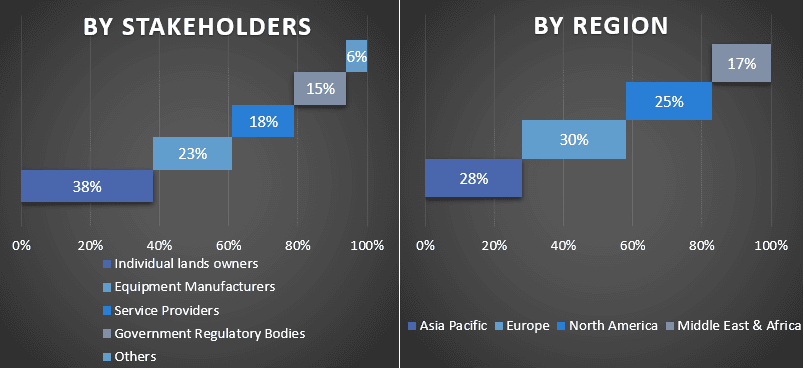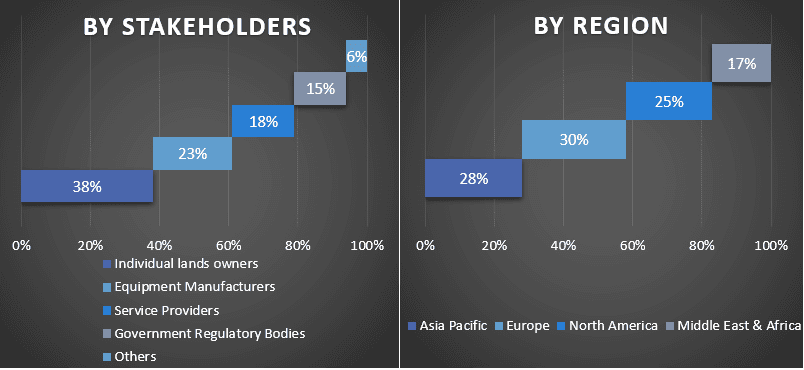Emphasis on Line (Import/Export Line and Transportation Line); Diameter (Below 24” and Above 24”; Product (Crude oil, Natural Gas, and Refined Product); and Region/Country.

The offshore pipeline market is expected to witness a CAGR of around 7% during the forecast period (2021–2027).
The growing demand for crude oil and natural gas around the world is propelling the offshore pipeline business forward. In 2018, global oil demand increased by 1.3 percent, owing to strong growth in the United States. The largest overall rise was seen in the United States and China. Furthermore, in the year 2020, air traffic volumes have expanded dramatically, particularly in China & India. The use of jet fuel has been a significant contribution to increased oil consumption. Also, according to the IEA, it accounted for 20% of overall world oil demand growth compared to the year 2019.
The countries are attempting to put resources into offshore oil and gas investigation exercises. During the forecast timeframe, oil and gas pipeline foundations in nations like the United States and Canada are supposed to keep running at full limits. Moreover, with the rising exercises in the Gulf of Mexico, the United States is supposed to observe huge development in the offshore pipeline market.
McDermott International, Ramboll, Saipem, Fugro, Subsea 7, Seanaat, Penspen, Sapura, and wood Group are some of the key players in the market. Several M&As along with partnerships have been undertaken by these players to facilitate customers with hi-tech and innovative products/technologies.
Insights Presented in the Report
“Amongst Lines, transportation line category to hold a significant share in the market”
Based on line type, the offshore pipeline market is segmented into Import/export lines and transport lines. The transport line portion is supposed to hold the biggest piece of the pie during the forecast period. Around 25,000 km of transport line pipeline network is supposed to be finished in the coming future. The increasing demand for energy and strategic reserves by the countries forces the oil companies to ensure safer and on-time delivery. To mitigate the risks associated with the transportation of crude oil and petroleum products the companies focus on the pipeline. Further, the economic viability of the transport line is one of the prominent factors contributing to the growth of this segment.
“Amongst Product, the refined product category is accounted for a significant market share in 2020”
Based on the product, the market is classified into natural gas, crude oil, and refined product. The refined product fragment is supposed to rule the market in the determined period. The rising population and urbanization along with the automotive industries increases the demand for the refined product in the past and would continue to grow at a higher rate. Key stakeholders in the industry have spotted the offshore pipeline technology as a strategic energy infrastructural investment for the long-term economic success and help in achieving the increasing demand of the several sectors including transportation, automotive as well as commercial, and institutional bodies.
“Amongst Diameter, above 24” category is expected to witness significant growth in the offshore pipeline market”
Based on the diameter, the market is classified into above 24-inch outer diameter and below 24-inch outer diameter. The diameter of the pipeline defines the capacity of the pipeline as well as it also provides information about the maximum bearing pressure and temperature which prevent any hazardous situation in the operating facility and supply chain. The 24-inch diameter pipeline is expected to grow in the future due to the increasing project allocation by the government and individual firms for deep-water drilling and exploration.
“North America to witness significant growth during the forecast period”
North America is expected to witness the highest CAGR in the offshore pipeline market, during the forecast period. New oil and gas reserves recognition and revelation across the region are driving the development of the offshore pipeline market. For instance, in September 2020, Equinor — an energy organization — declared the revelation of new oil and gas fields. Moreover, in October 2020, another oil and gas organization, Total, and its accomplices declared that they would assess a few improvement choices for commercializing another gas and condensate disclosure. Such revelations of new offshore oil and gas reserves across the area help the development of new plants and require new offshore pipelines for crossline transmission. Further, the up-gradation in adaptable line innovation is another variable that creates the interest in offshore pipelines across the locale. Thereby, boosting the offshore pipeline market.
Reasons to buy this report:
Customization Options:
The offshore pipeline market can further be customized as per the requirement or any other market segment. Besides this, UMI understands that you may have your own business needs, hence feel free to connect with us to get a report that completely suits your requirements.
1. Market Introduction
2. Research Methodology Or Assumption
3. Market Synopsis
4. Executive Summary
5. Global Offshore Pipeline Market Covid-19 Impact
6. Global Offshore Pipeline Market Revenue, 2019-2027f
7. Market Insights By Line
8. Market Insights By Diameter
9. Market Insights By Product
10. Market Insights By Region
11. Offshore Pipeline Market Dynamics
12. Offshore Pipeline Market Opportunities
13. Offshore Pipeline Market Trends
14. Demand And Supply-side Analysis
15. Value Chain Analysis
16. Competitive Scenario
17. Company Profiled
18. Disclaimer
Research Methodology for the Offshore Pipeline Market Analysis (2021-2027)
Analyzing the historical market, estimation of the current market, and forecasting the future market of the offshore pipeline market were the three major steps undertaken to create and analyze the adoption of offshore pipeline in major regions globally. Exhaustive secondary research was conducted to collect the historical market numbers and estimate the current market size. Secondly, to validate these insights, numerous findings and assumptions were taken into consideration. Moreover, exhaustive primary interviews were also conducted, with industry experts across the value chain of the offshore pipeline market. Post assumption and validation of market numbers through primary interviews, we employed a top-down/bottom-up approach to forecasting the complete market size. Thereafter, market breakdown and data triangulation methods were adopted to estimate and analyze the market size of segments and sub-segments of the industry pertains to. Detailed methodology is explained below:
Analysis of Historical Market Size
Step 1: In-Depth Study of Secondary Sources:
Detail secondary study was conducted to obtain the historical market size of the offshore pipeline market through company internal sources such as annual reports & financial statements, performance presentations, press releases, etc., and external sources including journals, news & articles, government publications, competitor publications, sector reports, third-party database, and other credible publications.
Step 2: Market Segmentation:
After obtaining the historical market size of the offshore pipeline market, we conducted a detailed secondary analysis to gather historical market insights and share for different segments & sub-segments for major regions. Major segments included in the report as lines, diameter, and product. Further country-level analyses were conducted to evaluate the overall adoption of testing models in that region.
Step 3: Factor Analysis:
After acquiring the historical market size of different segments and sub-segments, we conducted a detailed factor analysis to estimate the current market size of the offshore pipeline market. Further, we conducted factor analysis using dependent and independent variables such as various lines, diameter, and products of offshore pipeline equipment. A thorough analysis was conducted for demand and supply-side scenarios considering top partnerships, mergers and acquisitions, business expansion, and product launches in the offshore pipeline market sector across the globe.
Current Market Size Estimate & Forecast
Current Market Sizing: Based on actionable insights from the above 3 steps, we arrived at the current market size, key players in the global offshore pipeline market, and market shares of the segments. All the required percentage shares split, and market breakdowns were determined using the above-mentioned secondary approach and were verified through primary interviews.
Estimation & Forecasting: For market estimation and forecast, weights were assigned to different factors including drivers & trends, restraints, and opportunities available for the stakeholders. After analyzing these factors, relevant forecasting techniques i.e., top-down/bottom-up approach was applied to arrive at the market forecast about 2027 for different segments and sub-segments across the major markets globally. The research methodology adopted to estimate the market size encompasses:
Market Size and Share Validation
Primary Research: In-depth interviews were conducted with the Key Opinion Leaders (KOLs) including Top Level Executives (CXO/VPs, Sales Head, Marketing Head, Operational Head, and Regional Head, Country Head, etc.) across major regions. Primary research findings were then summarized, and statistical analysis was performed to prove the stated hypothesis. Inputs from primary research were consolidated with secondary findings, hence turning information into actionable insights.
Split of Primary Participants in Different Regions

Market Engineering
Data triangulation technique was employed to complete the overall market estimation and to arrive at precise statistical numbers of each segment and sub-segment of the offshore pipeline market. Data was split into several segments & sub-segments post studying various parameters and trends in the areas of lines, diameter, and product in the offshore pipeline market.
The main objective of the offshore pipeline market study
The current & future market trends of the offshore pipeline market were pinpointed in the study. Investors can gain strategic insights to base their discretion for investments on the qualitative and quantitative analysis performed in the study. Current and future market trends determined the overall attractiveness of the market at a regional level, providing a platform for the industrial participant to exploit the untapped market to benefit as a first-mover advantage. Other quantitative goals of the studies include:

Customers who bought this item also bought